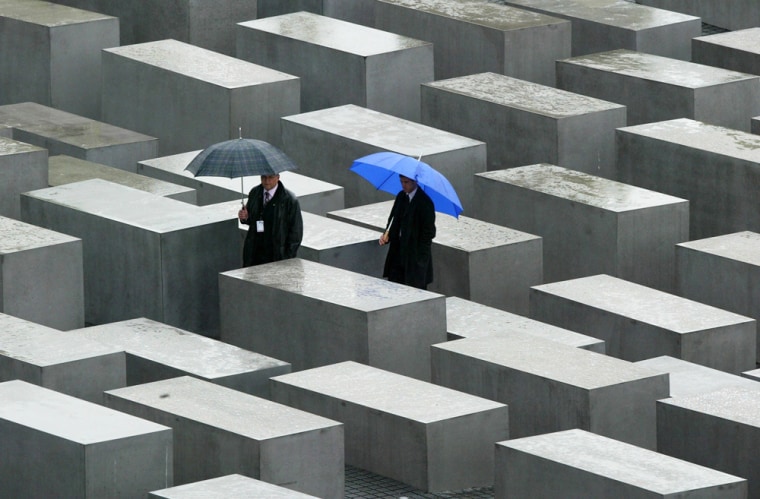Germany dedicated its long-delayed national Holocaust memorial Tuesday, a field of closely set concrete slabs in the heart of Berlin that tries to summon the helplessness of 6 million Jews killed by the Nazis.
However, Germany’s most prominent Jewish leader expressed concern at the ceremony that the memorial is too abstract to convey as powerful a message as authentic places of suffering, such as former death camps.
Parliament President Wolfgang Thierse joined Jewish delegates, Chancellor Gerhard Schroeder and other dignitaries at the opening of the sprawling memorial near the landmark Brandenburg Gate.
“Today we open a memorial that recalls Nazi Germany’s worst, most terrible crime — the attempt to exterminate an entire people,” Thierse said. He called it a sign that the big, reunited Germany that emerged at the end of the Cold War “faces up to its history.”
An undulating field of more than 2,700 slabs designed by American architect Peter Eisenman, the Memorial to the Murdered Jews of Europe is on a site resonant with both the terror of German history and the vibrancy of today’s reunited Berlin.
Adolf Hitler’s bunker once lay nearby. For 28 years, the site was in the no man’s land of the Berlin Wall built by communist East Germany to keep people from leaving during the Cold War. Germany reunified after the wall fell in 1989.
Story of loss, terror and survival
Holocaust survivor Sabina van der Linden riveted the audience with a deeply personal story of loss, terror and survival in Nazi-occupied Poland.
An 11-year-old girl when the Wehrmacht occupied her town in July 1941, she was sheltered at great risk by a Christian family and later survived by hiding in a forest. Her parents and brother died in the Holocaust.
In a message of reconciliation that won the longest applause of the afternoon, she said there could be no collective guilt for Germans and that her survival represented “a victory of all decent people over evil.”
“What have I learned?” said van der Linden, of Sydney, Australia. “I have learned that hatred begets hatred. I have learned that we must not remain silent and that each of us must fight discrimination, racism and inhumanity.”
Schroeder, visibly moved, clasped van der Linden’s hands as she left the podium.
Information center
Because of the abstract design, the memorial’s backers decided to add an information center with exhibits on Hitler’s campaign to wipe out European Jews.
But Paul Spiegel, the head of Germany’s Central Council of Jews, said the memorial remains “incomplete,” in part because some visitors might not go to the exhibit.
“Partly for this reason, it would have been desirable to point out the motives of the perpetrators and thereby allow a direct confrontation with the crime and the perpetrators,” he told the ceremony.
He said the memorial and the wrenching debate about it showed that it is less a place for Jews to recall the Holocaust than for Germans.
Jewish places of remembrance are former concentration camps, mass graves and “the many places in Germany where synagogues and community centers went up in flames,” he said.
Six million Jews perished in the Holocaust — in the Nazi gas chambers or in medical experiments, worked to death, starved or killed in other ways.
The completed field already draws sightseers, kept out by a metal construction fence that will come down Thursday, when the memorial opens to the public.
